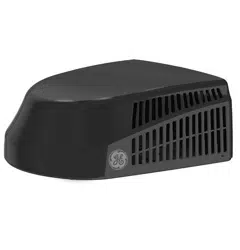Documents: Go to download!
User Manual
- User Manual - (English, French)
User Manual Air Conditioner
INSTALLATION INSTRUCTIONS
BEFORE YOU BEGIN
Read these instructions completely and carefully
- Save these instructions for local inspector’s use.
- Observe all governing codes and ordinances.
- Note to Installer – Be sure to leave these instructions with the Consumer.
- Note to Consumer – Keep these instructions for future reference.
- Skill level – Installation of this appliance requires a qualified RV technician.
- Completion time – Approximately 1 hour
- We recommend that two people install this product.
- Proper installation is the responsibility of the installer.
- Product failure due to improper installation is not covered under the Warranty.
- You MUST use all supplied parts and use proper
Installation procedures as described in these instructions when installing this air conditioner.
TOOLS YOU WILL NEED
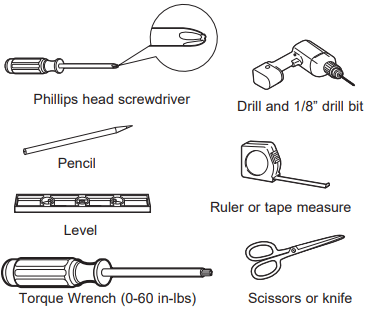
RARMN1A
Check the contents of the accessories supplied with your air conditioner as shown below:
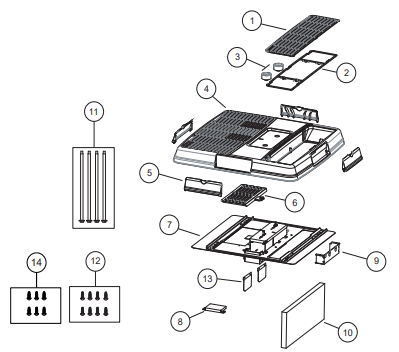
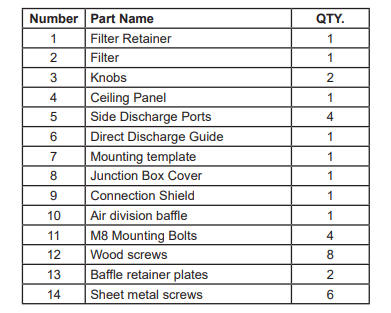
RARED1A
Check the contents of the accessories supplied with your air conditioner as shown below:
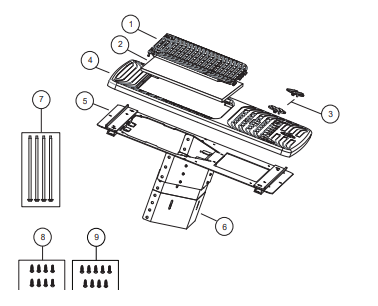

RAREN1A
Check the contents of the accessories supplied with your air conditioner as shown below:
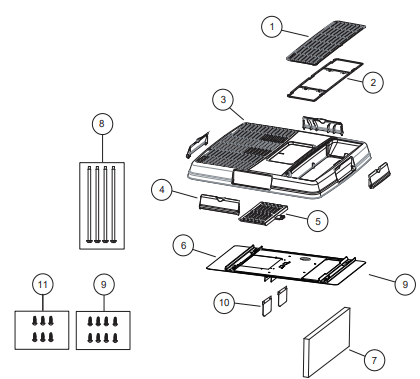
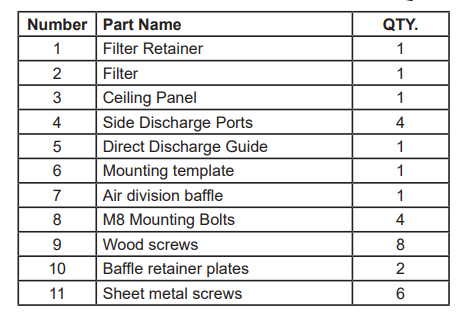
A. ROOF REQUIREMENTS AND DETERMINING LOCATION FOR INSTALLATION
Air conditioners covered in this manual are designed for installation on an RV’s roof. Installation of this air conditioner must be in accordance with NFPA 1192 and NFPA 70. For proper installation, there must be a 14- 1/4” x 14-1/4” (+-1/8”) square opening in the roof and ceiling of the RV. There must be 2 to 6 inches between the RV ceiling and roof. Air conditioners covered in this manual are designed fit over preexisting roof vent openings.
If a roof vent opening isn’t available. use the following guidelines:
Unit is to be installed centered side- to- side on the RV roof.
Unit is to be installed on a section of roof which is level with respect to the RV roof if parked on a flat. level surface.
Roof at the point of installation can have a maximum 15 degree tilt towards the front or rear of the RV.
Figure 1: Outdoor unit:
Figure 2: Indoor unit.
Figure 3: Ducted Unit
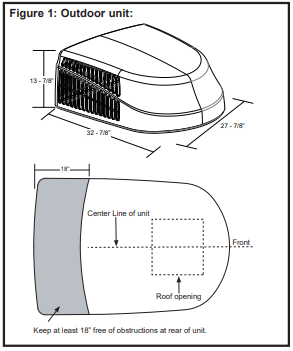


B. ROOF REQUIREMENTS AND PREPARATION
If a preexisting roof vent opening will be used
1. Unscrew and remove roof vent from RV.
2. Seal all holes and seams with a weather resistant sealant.
3. Measure the width and length of the vent opening.
If the opening doesn’t comply with the requirements above, it must be resized.
See other models: JGB920WEC2WW GSS25JEMCCC GSS23SGSASS CTX16BYBBLWW GSD2200G05BB
If a preexisting opening will not be used, a new opening will be cut through both the roof and ceiling of the RV.
1. This opening MUST be between structural roof members.
2. Do NOT cut structural roof members to create opening for this air conditioner. Doing so may cause damage to RV and air conditioner.
3. Do NOT create a low spot on the RV roof. Water can pool and may leak through the opening.
The square opening must be boxed with framing at least 3/4” thick to withstand the load from the compression bolts.
Be sure to provide an access hole for RV wiring toward the front of the 14 1/4 x 14 1/4” opening.
The roof and RV structures at the point of installation must be strong enough to support the air conditioner without any deflection. Deflection will allow water to pool at the air conditioner’s gasket, which may cause a leak.
C. ELECTRICAL REQUIREMENTS
These models require a 115-volt, 60-Hz protected with a 20-amp time-delay fuse or circuit breaker.
Use a minimum of sheathed, 12 AWG copper wire, with ground.
Be sure that 16” of supply wire is passed through the framing. This ensures enough wire is available for an easy connection in the junction box.
D. PLACING UNIT ON ROOF
CAUTION : LIFTING HAZARD. Ensure proper lifting methods and controls are used when lifting unit to the RV roof. Failure to do so can result in injury.
1. Remove unit from packaging and dispose of packaging.
2. Do not slide the unit on its mounting gasket. Damage to gasket can cause a leak. Using two people, lift the unit and place over the prepared opening. The front of the unit must face the RV’s direction of travel. Damage to condenser fan and coil will occur if this instruction is not followed.
3. Bring the ceiling assembly with all provided mounting hardware into the RV. All work on the exterior of the RV is now complete.
E. MECHANICAL CONTROL INSTALLATION
1. From inside the RV, double check the gasket’s
position and alignment above the roof opening.
Adjust if necessary. The air conditioner can be
moved and adjusted by pushing upwards from
inside the RV.
2. Reach through the base pan and pull the electrical
power cord from the air conditioner through the
ceiling opening.
3. Measure ceiling to roof thickness.
4. Cut rows from the bottom of the foam baffle
according the table below:

Best Practice: Cut away one row at a time, and check installation position of baffle. With the top foam compressed onto the air conditioner’s base pan, the bottom of the baffle should be flush to the ceiling opening.
5. Install 2 baffle retainer plates onto the ceiling assembly
6. Unscrew and remove 6 pin connection cover from the ceiling assembly.
7. Plug 6 pin connector from the roof mounted air conditioner into the electronic control box
8. Reassemble the 6 pin connection cover to the ceiling assembly.
9. Route the 115 VAC power cord through the strain relief of the ceiling assembly. Tighten the strain relief, making sure not to damage the wires.
10. Place foam baffle into position between 2 retainer plates.
11. Push the ceiling assembly into the roof opening, and begin hand-threading each of the 4 mounting bolts through the nuts in the base pan.
12. Tighten the 4 bolts evenly to 45 +- 5 inch pounds using a torque at least rated for 0-60 in-lbs. Even compression is required to prevent leaks through the gasket.
13. Remove junction box cover.
14. Using provided wire connectors, connect black to black, white to white, and ground to green.
15. Using electrical tape, secure the connectors to prevent any potential movement due to vehicle vibration.
16. Push wires and connections into the junction box. Reinstall junction box cover.
17. Align plastic ceiling panel to the metal assembly.
18. Install the 2 provided sheet metal screws to attach the plastic panel to the metal assembly. The filter must be removed to install these screws.
19. Install the 8 provided wood screws to secure the plastic panel to the RV ceiling. The air discharge doors should not be installed, or these screws will be difficult to drive.
20. Assemble the filter and air discharge doors to the plastic panel.
21. Install the 2 control knobs.
22. Installation is complete. Refer to “Controls” on page 12 before attempting to operate the air conditioner.
F. ELECTRICAL CONTROL INSTALLATION
1. From inside the RV, double check the gasket’s position and alignment above the roof opening. Adjust if necessary. The air conditioner can be moved and adjusted by pushing upwards from inside the RV.
2. Reach through the base pan and pull the electrical power cord from the air conditioner through the ceiling opening.
3. Push the ceiling mounting template into the roof opening and begin hand-threading each of the 4 mounting bolts through the nuts in the base pan.
4. Tighten the 4 bolts evenly to 45±5 inch pounds using a torque at least rated for 0-60 in-lbs. Even compression is required to prevent leaks through the gasket.
5. Place dividing baffle into position on the ceiling assembly. Ensure baffle is pressed against the base pan, forming an airtight seal.
6. Mount the dividing baffle to the mounting template using three screws.
7. Mount the dividing baffle to the framing timber using two screws, creating an airtight seal.
8. Mount main control box to the mounting template using four screws.
9. Remove two screws from main control box, allowing the bottom section to hinge open. Control board is now visible and accessible.
10. Route the 115 VAC power cord through the strain relief of the control box. Tighten the strain relief, making sure not to damage the wires.
11. Using provided wire connectors, connect black to black, white to white, and ground to green.
12. Using electrical tape, secure the connectors to prevent any potential movement due to vehicle vibration.
13. Route the 6 pin connector through opening of the strain relief of the control box. Mate 6 pin connector to the control box’s wire harness.
14. Using provided wire connectors, connect 2 furnace wires (blue), 3 thermostat wires (red, yellow, black), and two 12 VDC battery wires (red and black).
15. Rotate lower section of control box upwards, making sure not to crush any wires. Drive two screws, securing the control box closed.
16. Grasp indoor coil temperature sensor, which is hanging out of the control box. Reach up through the mounting template and base pan to install the sensor into the evaporator coil thermistor well (see figure below).
17. Align plastic ceiling panel to the metal assembly.
18. Install the 6 provided sheet metal screws to attach the plastic panel to the metal assembly. The filter and screw covers must be removed to install these screws.
19. Assemble the filter and screw covers to the plastic panel.
20. Installation is complete. Refer to thermostat operating instructions before attempting to operate

USING THE AIR CONDITIONER
Controls
Features and appearance will vary.
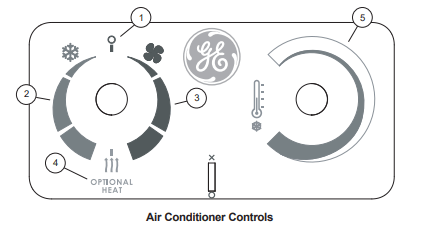
1. Power Off
The air conditioner is off in this position.
2. Air Conditioning Modes
In these positions, the compressor and fans will run to provide cold air. The three modes correspond to low, medium, and high fan speeds.
3. Fan Only Modes
In these modes, the fans will run to circulate air in the RV. The three modes correspond to low, medium, and high fan speeds.
4. Optional Heater
In this position, the optional heater will turn on, and the fan will operate at low speed.
5. Temperature Selection
This knob determines the room set point temperature. Turn this knob to increase or decrease how cold the air conditioner will make the room.
Air Direction
Use the lever to open or close vent on face of control panel.
Open or close 4 side ports to adjust airflow from the air conditioner.

Normal Operating Sounds
When your air conditioner is operating normally, you may hear sounds such as:
- Droplets of water hitting the condenser, causing a pinging or clicking sound. The water droplets help cool the condenser.
- Air movement from the fan.
- Clicks from the thermostat cycle.
- A high-pitched hum or pulsating noise caused by the compressor cycling on and off.
CARE AND CLEANING
Indoor Panel
Turn the air conditioner off and disconnect power from the air conditioner before cleaning.
To clean, use water and a mild detergent. Do not use bleach or abrasives.
Air Filter
The air filter behind the front grille should be checked
and cleaned at least every 2 weeks and cleaned if
necessary.
DO NOT operate the air conditioner without a filter
because dirt and lint will clog it and reduce performance.
Cleaning the Air Filter
1. Turn off the air conditioner.
2. Remove the air filter and grill assembly by carefully unsnapping the 6 tabs from the main panel. Then separate the filter from the grill.
3. Use a vacuum cleaner to clean air filter. If the air filter is very dirty, wash it in warm water with a mild detergent. Do not wash the air filter in the dishwasher or use any chemical cleaners. Air dry the air filter completely before replacing to ensure maximum efficiency.
4. Reassemble the air filter to the grill.
5. Carefully reassemble the grill and filter assembly to the main panel.
6. Turn on the air conditioner.
Cleaning the Front Panel
1. Turn off the air conditioner.
2. Clean the front panel with a soft, damp cloth.
3. Air dry the front panel completely.
4. Turn on the air conditioner.
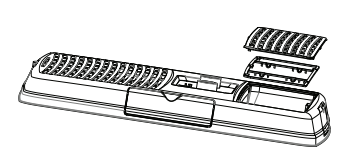
Annual Maintenance
Your air conditioner needs annual maintenance to help ensure steady, top performance throughout the year.
Call your local authorized dealer to schedule an annual checkup. The expense of an annual inspection is your responsibility
TROUBLESHOOTING
| Problem | Possible Cause | What To Do |
| Air Conditioner does not operate | A household fuse has blown, or circuit breaker has tripped. | Replace the fuse or reset the circuit breaker. If the problem continues, call an electrician. See “Electrical Requirements.” |
| The mode setting is in the OFF position. | Press POWER or turn the Mode control to an active setting. | |
| The local power has failed. | Wait for power to be restored. | |
| Air conditioner blows fuses or trips circuit breakers | Too many appliances are being used on the same circuit | Unplug or relocate appliances that share the same circuit. |
| Time-delay fuse or circuit breaker of the wrong capacity is being used. | Replace with a time-delay fuse or circuit breaker of the correct capacity. See “Electrical Requirements.” | |
| You are trying to restart the air conditioner too soon after turning off the air conditioner. | Wait at least 3 minutes after turning off the air conditioner before trying to restart the air conditioner. | |
| Air conditioner seems to run too much | The current air conditioner replaced an older model. | The use of more efficient components may cause the air conditioner to run longer than an older model, but the total energy consumption will be less. Newer air conditioners do not emit the “blast” of cold air you may be accustomed to from older air conditioners, but this is not an indication of lesser cooling capacity or efficiency. |
| The air conditioner is in a heavily occupied room, or heat-producing appliances are in use in the room. |
Use exhaust vent fans while cooking or bathing and try not to use heat-producing appliances during the hottest part of te day. A higher capacity air conditioner may be required, depending on the size of the room being cooled |
|
| Air conditioner cycles on and off too much or does not cool room in cooling mode | The air conditioner is not properly sized for your RV. | Check the cooling capabilities of your RV air conditioner. |
| The filter is dirty or obstructed by debris. | Clean the filter. | |
| There is excessive heat or moisture (open container cooking, showers, etc.) in the room. | Use a fan to exhaust heat or moisture from the room. Try not to use heat-producing appliances during the hottest part of the day | |
| The louvers or ducts are closed. | Make sure the louvers are open. | |
| The outside temperature is below 60°F (15°C). | Do not try to operate your air conditioner in the cooling mode when the outside temperature is below 65°F (18°C). | |
| The temperature of the room you are trying to cool is extremely hot. | Allow extra time for the air conditioner to cool off a very hot room. | |
| Windows or doors to the outside are open. | Close all windows and doors. | |
| The Temperature control is not at a cool enough setting. | Adjust the TEMP control to a cooler setting by pressing the minus button to reduce the temperature. Set the Fan Speed control to the highest setting. | |
| Water drips from cabinet into your house | The indoor coil may be frozen. | De-ice by running the fan only until clear |
| The air conditioner’s mounting gasket may not be sealed against the roof. | Check mounting bolts and tighten to 45 ± 5 in-lbs if necessary. |
